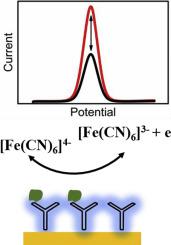Sensing and Bio-Sensing Research ( IF 5.4 ) Pub Date : 2021-07-30 , DOI: 10.1016/j.sbsr.2021.100445 Tânia S.C.R. Rebelo 1, 2 , José A. Ribeiro 1 , M. Goreti F. Sales 2, 3 , Carlos M. Pereira 1

|
This work reports the development of a simple and rapid electrochemical immunosensor for the determination of breast cancer biomarker Cancer Antigen 15–3 (CA 15–3). Disposable and cost-effective chips, consisting of gold screen-printed electrodes (AuSPEs), were used to develop the portable electrochemical devices for monitoring the biomarker in point-of-care (PoC), under clinical context.
The biosensor preparation consisted of two simple steps. First, a self-assembled monolayer (SAM) of mercaptosuccinic acid (MSA) was formed at the AuSPE surface. Then, the CA 15–3 antibody was covalently bound to the carboxylic groups standing at the electrode surface using EDC/NHS chemistry.
The performance of the developed immunosensor was evaluated by assessing the sensor sensitivity, linear response interval, selectivity and detection limit (LOD). The developed immunosensor provided a wide linear concentration range (from 1.0 to 1000 U mL−1) and low detection levels were achieved (LOD of 0.95 U mL−1), enabling the sensitive detection of the cancer biomarker at clinically relevant levels, using square wave voltammetry (SWV) as electroanalytical technique. Moreover, selectivity studies performed against other cancer biomarkers (CA 125 and CA 19–9) revealed that the antibody has high selectivity for CA 15–3 antigen. The immunosensor was applied to the quantification of CA 15–3 in artificial serum samples with satisfactory results.
中文翻译:

用于在床旁检测 CA 15-3 生物标志物的电化学免疫传感器
这项工作报告了一种简单快速的电化学免疫传感器的开发,用于测定乳腺癌生物标志物癌症抗原 15-3 (CA 15-3)。由金丝网印刷电极 (AuSPE) 组成的一次性和具有成本效益的芯片用于开发便携式电化学设备,用于在临床环境下监测即时 (PoC) 中的生物标志物。
生物传感器的制备包括两个简单的步骤。首先,在 AuSPE 表面形成巯基琥珀酸 (MSA) 的自组装单层 (SAM)。然后,使用 EDC/NHS 化学将 CA 15-3 抗体与位于电极表面的羧基共价结合。
通过评估传感器灵敏度、线性响应间隔、选择性和检测限 (LOD) 来评估开发的免疫传感器的性能。开发的免疫传感器提供了广泛的线性浓度范围(从 1.0 到 1000 U mL -1)并实现了低检测水平(LOD 为 0.95 U mL -1),从而能够在临床相关水平上灵敏地检测癌症生物标志物,使用平方波伏安法 (SWV) 作为电分析技术。此外,针对其他癌症生物标志物(CA 125 和 CA 19-9)进行的选择性研究表明,该抗体对 CA 15-3 抗原具有高选择性。将免疫传感器应用于人工血清样品中CA 15-3 的定量,结果令人满意。











































 京公网安备 11010802027423号
京公网安备 11010802027423号